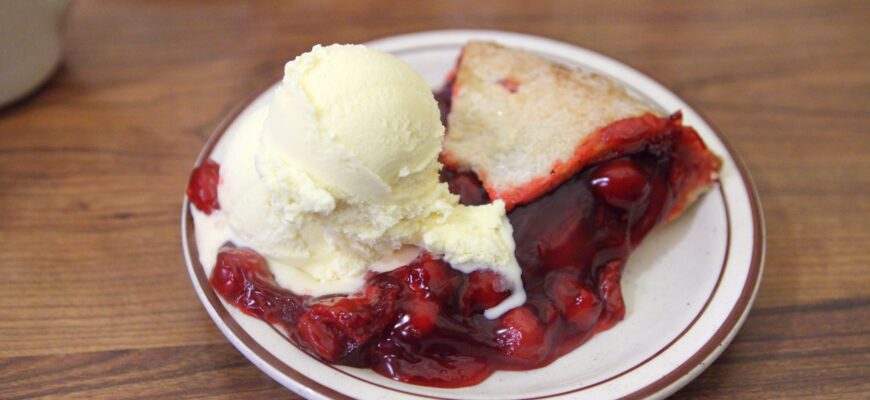The phrase à la mode often conjures images of a luscious scoop of vanilla ice cream melting atop a warm slice of pie. However, its origins and applications extend far beyond this sweet pairing. Delving into the cultural significance and culinary versatility of à la mode reveals a rich tapestry of meaning and tradition.
The Origins of À la Mode
Originating from the French language, à la mode translates to “in the fashion” or “in the style of.” Historically, this term was used to describe a fashionable trend, whether in clothing, behavior, or cuisine. In France, to say something is à la mode is to suggest its stylish or in vogue.
The culinary application of à la mode began in the 19th century. While the exact moment it entered the gastronomic lexicon in America is debated, its use to describe a dessert accompanied by ice cream became popular in the late 1800s. Some sources attribute the desserts popularity to John Gieriet, the owner of a hotel in Duluth, Minnesota, who served pie with ice cream and coined the term à la mode.
Cultural Significance
Beyond culinary trends, à la mode reflects a broader cultural appreciation for style and innovation. In the world of fashion, for example, being à la mode means embracing the current style or trend, thereby demonstrating an awareness and appreciation of contemporary aesthetics.
In culinary terms, à la mode has evolved to signify more than just ice cream accompaniment. It suggests a touch of elegance, an added layer of sophistication that elevates a dish. This reflects a cultural desire not only to consume food for sustenance but to experience it as an art form.
Culinary Applications
While the most common association of à la mode is pie with ice cream, its application is diverse and varied:
- Savory Dishes: In traditional French cuisine, a dish described as à la mode might include braised beef with a flavorful sauce, showcasing the chefs style or regions signature ingredients.
- International Influence: The concept of à la mode can be found in other cuisines, where a dish is tailored or adapted to reflect local tastes or trends.
- Modern Gastronomy: Today, chefs continue to experiment, applying à la mode to novel combinations, such as savory dishes topped with ice cream or sorbet, offering a creative twist on the traditional.

The Sweet Spot
Ultimately, the charm of à la mode lies in its ability to infuse a simple dish with a sense of style and delight. It bridges the past and present, blending tradition with innovation. Whether youre savoring a classic apple pie à la mode or experiencing a new culinary creation, the term invites us to appreciate the artistry and flair that makes each meal an experience to cherish.
So, next time you indulge in something à la mode, take a moment to savor not just the flavors but the cultural tapestry it represents—a timeless celebration of taste, creativity, and elegance.
À la Mode in Pop Culture
The concept of à la mode isnt confined to culinary circles. It has permeated pop culture, influencing everything from music to movies. The terms flexibility allows it to be adapted and reinterpreted across various forms of media, often symbolizing the zeitgeist or a particular cultural moment. For instance, a film might be described as à la mode if it captures the essence of contemporary style or thought, making the term a bridge between food and broader cultural movements.
À la Mode as a Symbol of Innovation
In todays fast-paced world, being à la mode is synonymous with embracing innovation and creativity. In the culinary world, this might mean experimenting with molecular gastronomy or reimagining traditional dishes with modern twists. Chefs and restaurateurs who stay ahead of the curve by being à la mode are often those who set the trends, influencing both palates and the industry at large.
Culinary Creativity: Beyond the Traditional
The modern interpretation of à la mode encourages a departure from the norm, urging chefs to think outside the box. This could involve incorporating unexpected ingredients, exploring cross-cultural influences, or presenting dishes in visually stunning ways that transform the dining experience. The goal is to surprise and delight, engaging diners not just with taste but with presentation and creativity.
The Evolution of À la Mode in the Digital Age
In the digital age, the concept of à la mode has taken on new dimensions. Social media platforms like Instagram and TikTok have become hotbeds for showcasing à la mode dishes, with food influencers and chefs sharing their latest creations. This digital exposure allows culinary trends to spread rapidly, making à la mode a global phenomenon that transcends geographical boundaries.
Conclusion: Embracing the À la Mode Lifestyle
To live à la mode is to embrace a lifestyle of creativity, adaptability, and appreciation for the finer things. Whether in fashion, culture, or cuisine, à la mode invites us to explore and innovate, to set trends and break boundaries. It is a celebration of style and substance, encouraging us to savor every moment with a sense of flair and sophistication.
So, whether youre enjoying a decadent dessert or exploring a new fashion trend, remember that à la mode is more than just a phrase—its a way of life that celebrates the art of living with taste and elegance.


The explanation of à la mode’s cultural significance was enlightening. It’s interesting to see how something as simple as a dessert can reflect broader cultural trends.
As a foodie, I found the culinary applications section particularly intriguing. It’s wonderful to see how à la mode can be applied beyond just sweets.
I absolutely loved the deep dive into the origins of à la mode. It was fascinating to learn how a simple phrase has such rich cultural and culinary significance!
This article beautifully illustrates how à la mode is not just about dessert but also about style and sophistication in various facets of life. A delightful read!
I appreciate the detailed exploration of à la mode’s history and its impact on both fashion and cuisine. This article is a great reminder of how interconnected our world really is.
The historical context provided in this article really opened my eyes to the broader meaning of à la mode. It’s amazing how language evolves and connects with different aspects of culture.